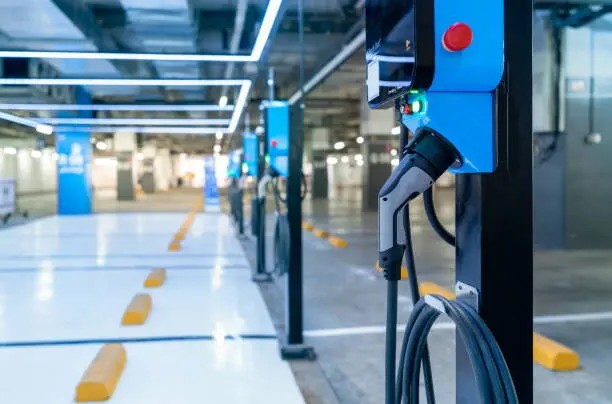The Strategic Intersection of Parking and EV Charging
In today’s rapidly evolving mobility landscape, electric vehicle (EV) adoption is accelerating. As more drivers make the switch to electric, the demand for reliable, accessible EV charging infrastructure grows exponentially. One of the most strategic places to meet this demand is where vehicles already dwell—parking garages.
Whether in downtown commercial centers, office buildings, residential complexes, or airport structures, integrating China EV chargers offers an opportunity to improve service offerings, attract eco-conscious clientele, and boost customer satisfaction. Charging and parking are inherently connected—making garages ideal venues for deploying electric vehicle supply equipment (EVSE).
EV Chargers in Parking Garages: Tailored Use Cases
Each type of parking facility serves distinct user needs, requiring a customized approach to charger type, placement, and energy management.
1. Office Building Garages
These garages cater to commuters who typically park for extended hours. Level 2 chargers are ideal here, allowing full charges throughout the workday.
Adding a few Level 3 DC fast chargers can accommodate short-term visitors or clients. Smart charging systems enable load balancing, while corporate charging packages serve as attractive perks for tenants and employees.
2. Medical Facility Parking
Hospitals and healthcare centers serve staff, patients, and vendors.
- Staff lots: Level 2 chargers support long shift durations.
- Visitor areas: Level 3 chargers enable faster turnover.
- Facilities should also include fleet charging options for hospital-owned EVs and ensure compliance with ADA standards and safety regulations.
3. Airport Parking Garages
Airports see a mix of long-term and high-turnover traffic:
- Long-term travelers: Level 2 chargers with valet rotation services maximize availability.
- Rideshare zones and rental fleets: Level 3 chargers support quick top-ups and operational efficiency.
- EV charging also represents a new revenue stream and reinforces the airport’s environmental commitment.
4. Event Venues & Downtown Parking
Entertainment hubs experience predictable employee traffic and event surges.
- Employee parking: Level 2 chargers meet routine needs.
- Public areas: Level 3 chargers accommodate quick charges during concerts or games.
- App-based reservations, dynamic pricing, and visible signage help manage peak-time demand.
5. Retail Shopping Centers
Offering EV charging elevates shopping centers’ appeal.
- Most shoppers: Level 2 chargers suffice for typical visit durations.
- High-volume locations: Integrating fast chargers and leveraging them for loyalty programs or advertising can turn EVSE into a revenue and marketing asset.
6. Hotels and Resorts
EV charging signals luxury and sustainability.
- Overnight guests: Level 2 chargers offer convenience and reliability.
- Day visitors: Level 3 options accommodate short stays.
- Integration with valet services and loyalty programs enhances the guest experience and differentiates the property in a competitive market.
7. Residential Garages & Multifamily Housing
Apartments and condos face increasing demand for home-charging solutions.
- Best fit: Dedicated Level 2 chargers with billing integration.
- Management tools: Features like usage tracking and time-of-use optimization provide efficiency.
- In many competitive housing markets, EVSE is no longer a luxury—it’s an essential amenity.
Core Benefits of Adding EV Chargers to Parking Facilities
1. Attract and Retain Customers
EV drivers prioritize convenience. Offering charging where drivers already go—work, shop, travel, or relax—builds loyalty and positions facilities as modern, driver-focused destinations.
2. Maximize Space Efficiency
Wall-mounted or compact chargers add value to existing parking real estate. Long-term parked cars can actively contribute to revenue and customer satisfaction through consistent charging.
3. Enhance Property Value
EV charging improves a property's long-term appeal. It contributes to sustainability certifications like LEED and helps meet government green mandates—appealing to tenants, buyers, and investors.
4. Create New Revenue Streams
Charging stations can be monetized through flexible billing models:
- Pay-as-you-go
- Tiered pricing
- Subscriptions
- Management platforms provide insights into usage, peak times, and performance. Some chargers even feature digital screens for paid advertising.
5. Strengthen Environmental and Brand Reputation
Sustainability initiatives resonate with eco-conscious consumers, especially younger demographics. EV charging helps position your brand as future-ready and environmentally responsible.
Best Practices for EV Charger Deployment in Garages
- Conduct a Site Assessment: Analyze electrical capacity, user flow, and space layout.
- Select the Right Mix: Balance Level 2 and Level 3 chargers based on dwell time and user profiles.
- Ensure ADA Compliance: Follow accessibility guidelines from the outset.
- Use Smart Load Management: Software tools optimize power usage and prevent demand spikes.
- Partner with a Reliable Provider: Choose a vendor with scalable hardware, robust network support, and upgrade flexibility.
- Promote Availability: Use signage, apps, and online directories to boost charger visibility and usage.
Conclusion: Future-Proofing Your Parking Facility
Installing EV chargers is more than a tech upgrade—it’s a strategic move toward smarter mobility, better customer experience, and long-term value. As the EV revolution continues, facilities that integrate EVSE today will be better positioned for tomorrow’s market realities.
Whether you manage an airport, office complex, retail center, or multifamily property, now is the time to act. EV charging doesn’t just fill a need—it creates a competitive edge.Know more about Google SEO Directory





Comments